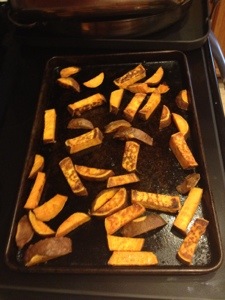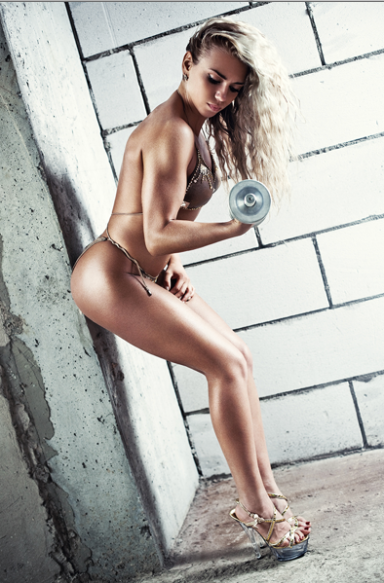The International Association for Dance Medicine and Science has published a fantastic fact sheet on dancer nutrition, that I am going to reproduce here with my own comments. Credit goes to them for anything in quotations, link can be found here. I have italicized the take home points.
“To perform at their best, dancers need to be well fueled for classes, rehearsals, and performances.
The main challenge facing many dancers is ingesting sufficient quantities of food to meet the energy demands of dance. The first step in planning a high performance diet is to be sure that the dancer is obtaining adequate caloric intake. The easiest rough estimate of how many calories a dancer requires during heavy training is 45-50 calories per kilogram of body weight for females and 50-55 calories per kilogram of body weight for males.” To put this into perspective, a girl weighing around 120 lbs should be eating around 2700 calories a day.
“A low caloric intake will not only compromise energy availability, it can also lead to an under-ingestion of many micronutrients that could affect performance, growth and health. After calculating the number of calories needed, the next step is to estimate the necessary amount of carbohydrate, fat, and protein, the building blocks of the diets.”
“Carbohydrate
A dancer’s diet should be composed of about 55-60% carbohydrate, 12-15% protein, and 20-30% fat. During heavy training and rehearsals the amount of carbohydrate should be increased to about 65%. The reason is that carbohydrate is the major energy source in muscles. Ingested carbohydrate is broken down into simple sugars (glucose) in the digestive tract then stored in muscle in the form of glycogen, the primary fuel for energy production. Dancers who do not ingest sufficient carbohydrate in their diet will compromise their ability to train because of low muscle glycogen levels. They may feel more fatigued during classes and rehearsals.”
I want to go ahead and dispel any “oh I don’t eat carbs I’m a dancer I have to be skinny” nonsense right now. Stop. You’re doing yourself a disservice. Carbs are HUGELY important in a dancer’s diet. If you don’t eat carbs, you won’t have any energy. Dancing without carbs is like trying to drive with no fuel. It just doesn’t work!
“To achieve a high carbohydrate diet, food choices should be complex carbohydrate (bagels, cereal, bread, english muffins, pasta, rice) rather than simple sugars, because complex carbohydrate has many micronutrients associated with it (nutrient dense) while simple sugars are nutrient poor. The estimated carbohydrate need is 6-10 grams of carbohydrate per kilogram of body weight.
In addition to meals, other times when carbohydrate ingestion is important are before, during, and after class, rehearsal, or performance. About 1-2 hours prior to these activities, a small carbohydrate snack should be consumed. This will increase glucose levels in the circulation and “top-off” muscle glycogen stores. A carbohydrate snack, such as a bagel or commercially available “energy” bars, can provide the added boost needed for optimal performance.
During long rehearsals it is also important to ingest some carbohydrate to maintain circulating levels of glucose to prevent fatigue. A good way to ingest this carbohydrate is in solution such as sports drinks that are specially formulated to contain the right amount of carbohydrate (6-8% glucose) to empty from the stomach quickly. Ingesting carbohydrate in a solution provides the added benefit of fluid replacement.
After a period of dancing, the muscles require an adequate supply of carbohydrate to replenish the muscle glycogen stores. Because the fastest rate of glycogen re-synthesis occurs in the 2 hours following exercise, it is important to ingest carbohydrate as soon as possible after a long or strenuous exercise period to refill muscle stores and be ready for the next activity.”
“Fat
Fat from the diet provides structure for all cell membranes, comprises the insulating layer around nerves, forms the base of many hormones, is needed for the absorption of fat soluble vitamins, and is an important fuel for muscles. The estimated grams of fat in the diet are about 1.2 gm per kilogram of body weight. Because ingestion of high amounts of saturated fats is associated with chronic disease, the recommended amount of saturated fat in the diet should be less than 10%.
Muscle and adipose (fat) tissue store fat in the form of triglycerides. During exercise, triglycerides are broken down into fatty acids which are metabolized to produce energy for muscle contraction. Fatty acids are used as an energy source in the muscle for endurance activities such as during a long rehearsal where the body is continuously exercising for over 20 minutes at a time. A diet too low in fat can have serious health consequences and ultimately can impair performance.”
“Protein
Adequate protein ingestion is essential for all dancers who are training. For those dancers who are not building muscle, protein is needed to repair the breakdown of muscle fibers that are stressed by constant use. Protein is also used as an auxiliary fuel, and it is important for synthesizing the many enzymes necessary for metabolism. The estimated protein need is 1.4-1.6 grams of protein per kilogram of body weight. For non-vegetarians, chicken or turkey without the skin are excellent low fat protein sources. For vegetarians, tofu, seitan (wheat gluten), and mixtures of beans and rice are good protein choices. Protein powders are not necessary, even for male dancers, if they are following the recommendations above. If a protein supplement is warranted, the best choice is milk powder. The high tech and expensive protein supplements on the market are not any better than simple dry milk.”
“Micronutrients
Vitamins and minerals comprise the micronutrients in the diet. Water soluble vitamins are the B vitamins and vitamin C. Vitamins A, D, E, and K are fat soluble. The B vitamins play important roles in energy production (especially thiamin, riboflavin, niacin and vitamin B6) and in red blood cell formation (folic acid and vitamin B12). Deficiency of these vitamins can impair performance. Vitamins A (beta carotene), C, and E function as antioxidants that are necessary for the repair of over-stressed muscles and are needed to help muscles recover from strenuous classes and rehearsals. Vitamin D is important in bone formation.
Minerals are classified into macrominerals that are needed in levels of over 100 mg/day and microminerals (trace minerals) that are needed in levels of under 100 mg/day. Macrominerals are calcium, phosphorus, and magnesium, but only calcium will be discussed because of its importance for dancers. There are 9 trace minerals but only iron and zinc will be discussed because of the possible deficiency of these minerals in dancers.
Calcium is important in bone formation. During the first 2-3 decades of life, bone mass is developed and thereafter, bone formation ceases. It is essential to ingest adequate calcium during the bone growth years. Low bone mass and low calcium intake are also associated with increased risk of stress fractures. The richest source of calcium is dairy products.
Iron is a trace mineral needed to carry oxygen in the blood because it forms part of the hemoglobin molecule. Oxygen is used for the production of energy in muscle cells. Dietary iron is of two types, the heme, found in meat, and non-heme, less absorbable type found in plants. Dancers should include some lean red meat in their diet to obtain adequate iron. However, if dancers are vegetarians, then they should be careful to ingest foods rich in iron, like whole grains. Because vitamin C increases the absorption of non-heme iron, ingesting a source of vitamin C along with food will maximize absorption of non-heme iron. Red meat is also a good source of zinc which is a component of several enzymes important in energy production and plays a role in red blood cell production.
Dancers should be cautious about taking vitamin and mineral supplements because supplements containing only selected micronutrients could do more harm than good. Excessive amounts of one can interfere with the absorption of another, and megadoses of some vitamins and minerals could be toxic. Adjusting the diet so that it is rich in micronutrients is the recommended means of obtaining necessary micronutrients. Furthermore, there are numerous phytochemicals in food that impart important health benefits.
To obtain all important micronutrients, dancers should increase the amount of fresh fruit and vegetables (recommended 5 servings of fruit or vegetables per day), whole grains, dairy products, and lean red meat. Because not all vitamins or minerals occur in all foods, dancers should ingest a wide variety of foods. A calorie restricted or monotonous diet could lead to a deficiency in some of these vitamins and could impair the ability to train strenuously and recover. As an insurance policy, a multivitamin/mineral supplement containing equal to or less than the recommended level of each micronutrient will provide a balance that is not harmful. Read the label carefully before purchasing a vitamin/mineral supplement.”
Restricted diet= restricted performance.
“There are many dietary supplements on the market designed to enhance performance or decrease body weight. Dancers should be warned that these supplements are ineffective or even dangerous. Dietary supplements can be marketed without adequate proof that they are effective or safe.”
Fluid
Exercise increases heat production by muscles. Cooling the body depends on evaporation of sweat from the skin. Sweat losses during a hard class or long rehearsal can be substantial-up to 2 liters/hour. Fluid loss results in dehydration that can impair performance and mental functioning, such as the ability to quickly pick up complicated choreographic combinations and execute them effectively.
A cup (8 ounces or 250 ml) of fluid every 15 minutes is recommended. Whenever there is a break in class or rehearsal, the dancer should have ready access to fluid, and they should be encouraged to drink because the thirst mechanism does not keep up with the body’s need for fluid. A water bottle or sport drink should be part of a dancer’s “gear,” and, if possible, the dancer should be able to bring the bottle into the studio for frequent drinks. Following class and rehearsal, dancers should continue to increase fluid consumption for the next few hours. Avoid carbonated drinks and large quantities of fruit juice.
A simple way to monitor hydration is to check urine color: clear to light yellow is hydrated; yellow to dark yellow means dehydrated. One caveat, vitamin B supplements will result in yellow urine and make this dehydration “test” inaccurate.”
I know that was long, so congratulations if you made it here and you’ve read everything above! I hope this helps to guide fellow dancers towards a healthier lifestyle.
Now for some useful resources:
Any fellow Irish dancers: this is a wonderful pamphlet on Irish dance nutrition
If you’ve ever had any questions about the nutritional value of what you eat, this site will answer your questions.
Again, thank you for reading, I hope that someone out there found this useful!



